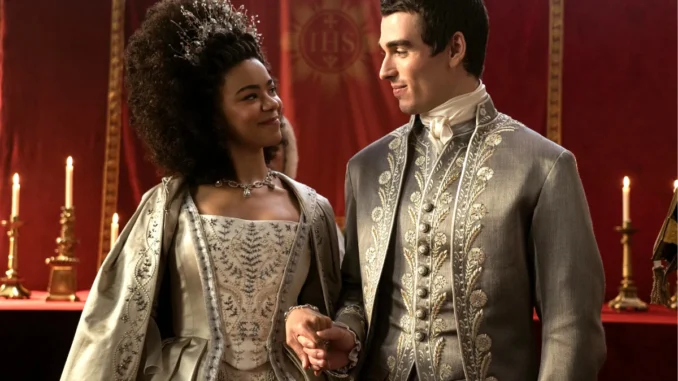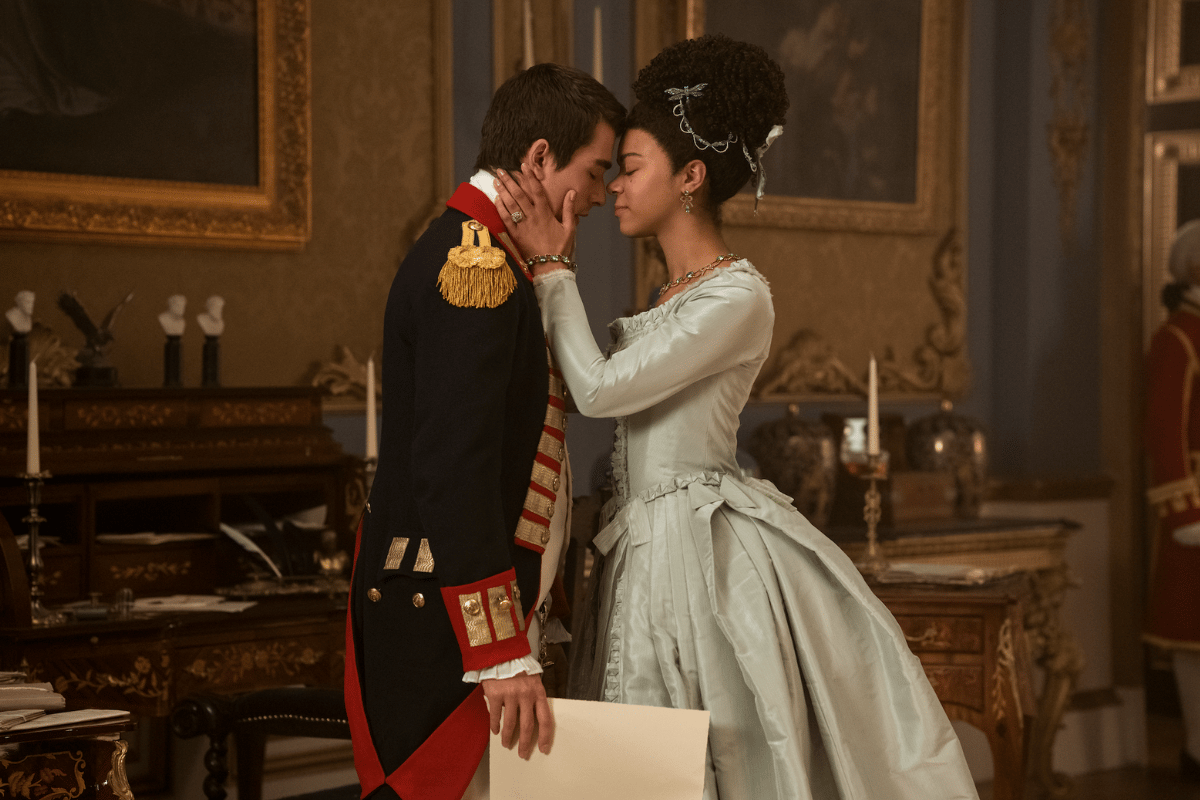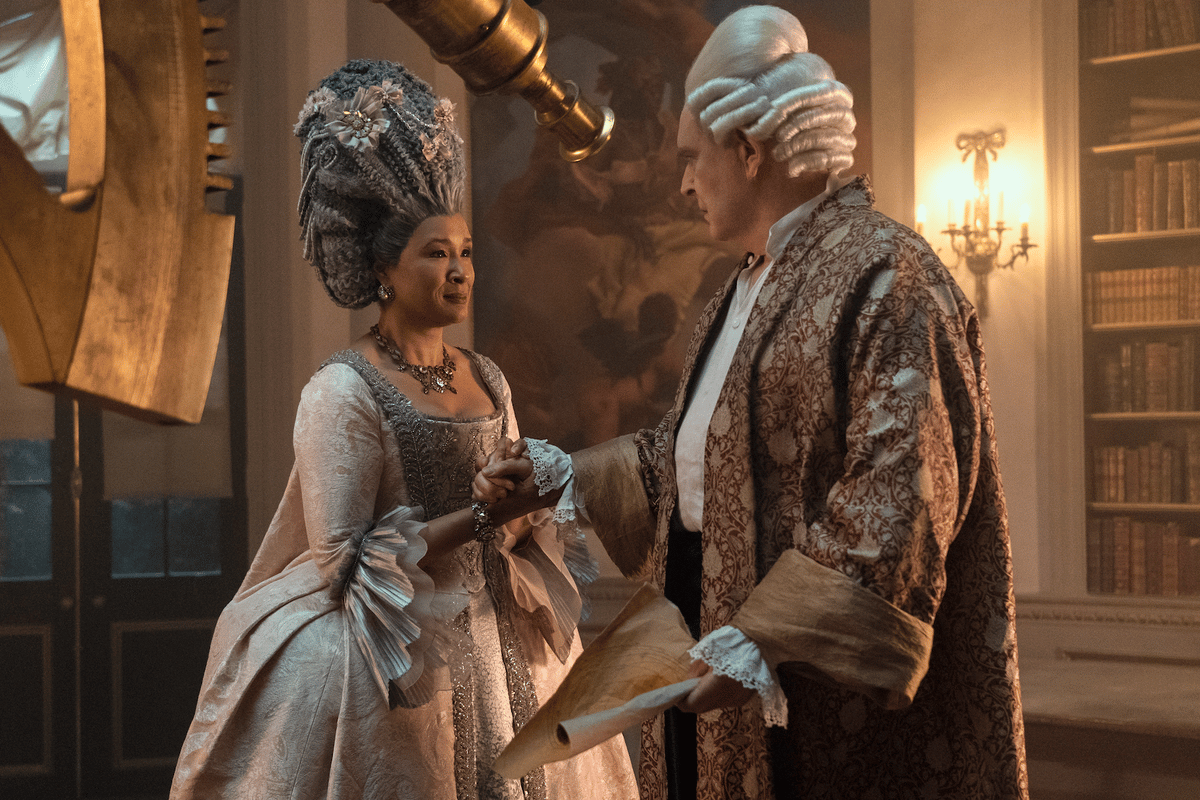
Queen Charlotte: A Bridgerton Story is here – and you best believe I watched the whole season in one hit as soon as it was available.
So far in the Bridgerton universe, we’ve seen one woman make her debut into Regency London’s competitive marriage market, a couple wrestle with their not-perfect-on-paper feelings for one another, a scandalous gossip column that wreaks havoc on high society, some kick-arse female characters, and the smooth pipes of Julie Andrews narrating.
Need I go on?
Whenever the news of a prequel arises, the reception is usually quite blasé.
But Queen Charlotte hits different. It’s a little darker. There’s strong chemistry. And it has a storyline that sometimes leaves you with a lump in your throat.
The first introduction to King George III (played by Corey Mylchreest) and Queen Charlotte (played by India Amarteifio) is idyllically Bridgerton-esque. There’s some sassy banter when Charlotte initially tries to hightail over a palace wall in a poofy Regency-era dress to avoid an arranged marriage to George.
Yet after meeting one another, the sparks begin to fly — and the push and pull begins.
But there’s another equally important character that permeates George and Charlotte’s storyline. And it’s George’s mental illness.
In the show a specific diagnosis isn’t given, rather it’s referred to as ‘fits’ and ‘mania’.
Though Queen Charlotte brands itself as fictional, there are parts of the TV show that do in fact mirror history.
Historians far and wide have said the real King George III did likely suffer from mental illness. The royal family’s official website refers to George as having ‘hypomania’, a type of mania that is often part of bipolar disorder.
And using the evidence of thousands of the king’s own handwritten letters, Dr Peter Garrard and Dr Vassiliki Rentoumi told the BBC that the king did indeed have a “psychiatric illness”.
This is in turn reflected in Queen Charlotte, with viewers watching Charlotte navigate a passionate new love with a man who has a prolonged and increasingly debilitating illness.
For George, a whole episode is then dedicated to his perspective entirely. It’s a tricky balance, but one the show manages to capture – particularly when it comes to the scenes where George is receiving treatment, reflective of the era and ignorance of mental illness then.
But the illness is dealt with compassionately and with consideration. It doesn’t feel included for shock value or for dramatisation, rather as an example of how multi-dimensional they want the characters and their relationships to be.
So yes, there are parts that can feel heavy, given this Bridgerton spin-off isn’t simply a ‘will they won’t they fall in love’ whimsical romance.
And that’s what makes it so great.
It’s gritty. It’s complex, particularly given the storyline between the young Charlotte and George is juxtaposed with the bittersweetness of the present day. And it has the perfect balance between light and shade.
As someone who has also experienced looking after a loved one with a complex mental health condition, it’s a storyline I’ve hoped to see reflected in mainstream television for a long time.
So seeing it represented on screen – and to see it done so well – hits different.
 Queen Charlotte and King George III. Image: Netflix.
Queen Charlotte and King George III. Image: Netflix.
 One of the most powerful scenes from the whole of the Bridgerton TV franchise, with Queen Charlotte and King George III. Image: Netflix.
One of the most powerful scenes from the whole of the Bridgerton TV franchise, with Queen Charlotte and King George III. Image: Netflix.
One aspect that Queen Charlotte doesn’t fully tackle is that of race. In the early days of Bridgerton, one of the characters explains that their fictional Regency-era realm is post-racial, thanks to the relationship between George and Charlotte.
In this prequel, the subject of race is touched on, but perhaps not as meaty as one would like.
But there is still a bunch of other fabulous factors that make Queen Charlotte superior to Bridgerton.
We’ve got a stellar storyline with Lady Agatha Danbury (played by Adjoa Andoh), who for the last two seasons has mostly orbited around her younger counterparts. Now in Queen Charlotte, Lady Danbury is given the airtime she deserves. The arc surrounding her sexless and loveless marriage to a man decades her senior and her eventual sexual reawakening is *chef’s kiss*.
An equally steamy and heartfelt subplot is the relationship between the king and queen’s secretaries Brimsley (played by Sam Clemmett) and Reynolds (played by Freddie Dennis).
It’s the first time a queer love story has been introduced to the Bridgerton realm. There are obstacles, lust and complexity, immediately hooking you in.
As for the intimacy scenes in general throughout the season – it’s a vibe. It’s not as horny as the first season (the Duke of Hastings we miss you) but the love scenes, piercing looks and lingering touches in Queen Charlotte certainly deliver.
The glitz and pomp is still just as fabulous as Bridgerton. And considering in the last week we’ve had a certain real-life coronation shoved down our throats, I have to say that the one depicted in Queen Charlotte is much more riveting to watch.
It’s a rarity for a prequel to be better than the original. But Queen Charlotte does this in spades, with plenty of emotion, curiosity, eroticism and poignancy. It highlights that not every love story looks the same – but that every love story is valid.
Feature Image: Netflix.
